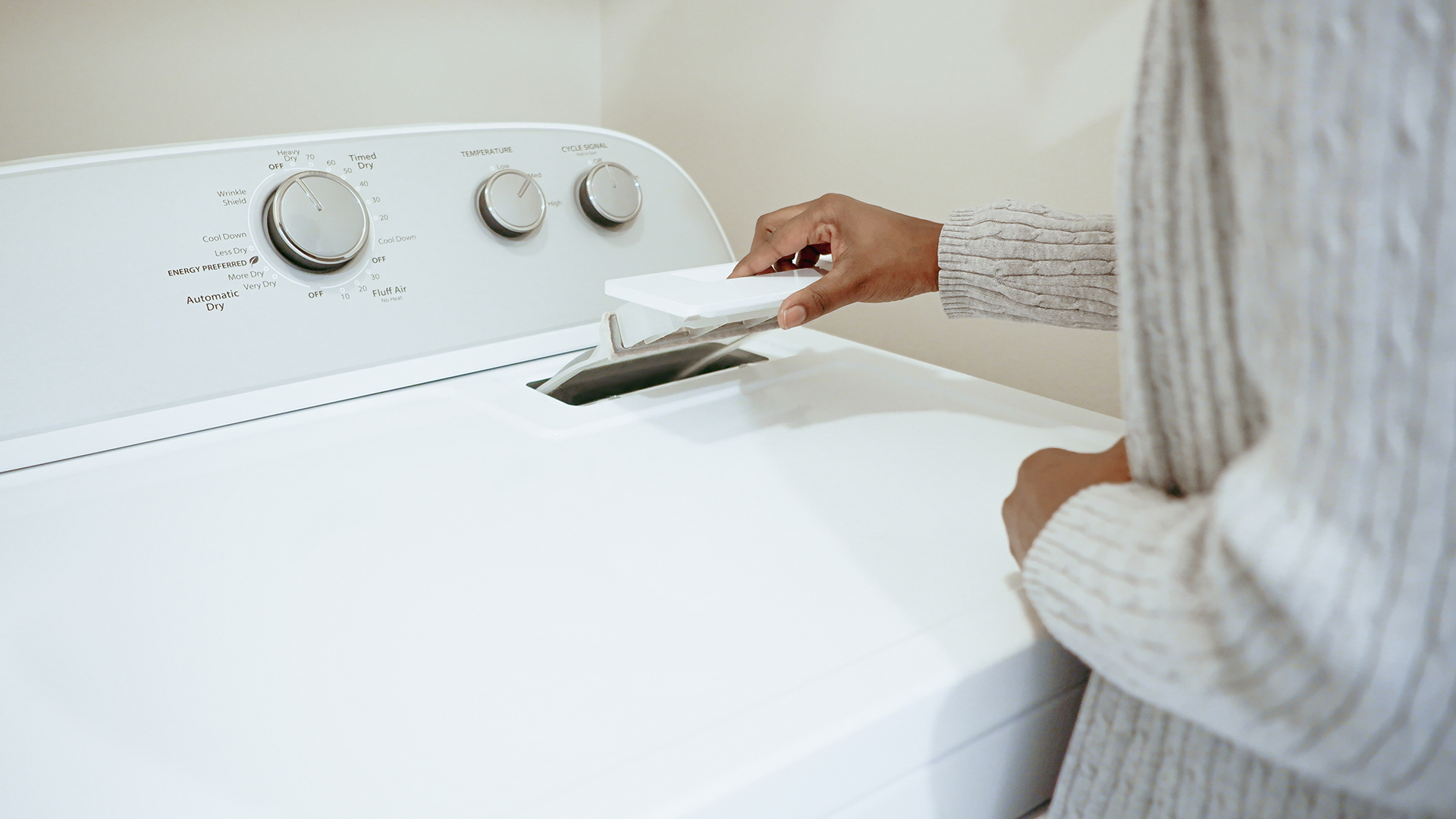How to clean a dryer lint trap
Fed up with finding dust in your laundry?

If your dryer is not drying as effectively as it used to, it could be because the lint trap is full, in which case you'll want to know exactly how to clean a dryer lint trap. This way, you can improve how well your dryer functions and keep your clothes free from any dust balls.
Cleaning a dryer lint trap is really quite easy with a few simple tips. If your lint trap is only lightly soiled, then emptying it normally should be easy, but if it's covered in old lint, then it might need some extra attention.
A dirty lint trap can cause excess dust to stay in your dryer and stick to your clothes, which can be a nightmare - especially when you don't want to use the old, sticky lint roller that has been sitting in your cupboard for months. If the lint trap is especially full, it can also block the ventilation of your dryer and severely impact the drying process, leading to damp clothes, which will need an additional drying cycle.
Whether it's the best dryers or the best washer dryer combos, we will show you how to clean your lint trap easily and effectively.
Why should you regularly clean your lint trap?

Tim David, CEO of Airlucent says: "Outside the obvious fire dangers that can be caused by not cleaning out the lint trap in a dryer, I always recommend to my clients to keep the following in mind: If you have respiratory issues, you should use a small air purifier in your laundry room and wear an N95 mask when handling the lint catch. Lint is made up of tiny fibers and can become airborne when cleaning the lint trap. Inhaling lint particles can cause respiratory problems, especially for those with pre-existing conditions like asthma."
It's important to regularly clean your dryer lint trap for a number of reasons. A build-up of lint is both dangerous and unhygienic. These are the main reasons why you should clean your lint trap frequently:
• Lint is a fire risk
Lint is very flammable, and a build-up of lint can be a serious fire hazard. In the US, there are around 16,000 dryer fires every year, one-third of which are caused by a build-up of lint or dust in the lint trap. Cleaning the trap regularly reduces this risk and makes for a safer home for you and your loved ones.
Sign up to receive the latest news, reviews, buying guides and deals direct to your inbox
• Excess lint can cause harmful mold and germs to spread
Lint is a breeding ground for harmful microbes, and if the excess lint means that your dryer can't dry your clothes properly, then the excess moisture and temperature make the perfect conditions for mold and mildew to form. This can irritate your skin or even make you sick. Mold can also create foul odors that will stick to your clothes and require you to rewash laundry to remove it.
• Lint removal improves dryer efficiency
A build-up of dust and lint in the lint trap can reduce airflow in your dryer, making it much harder to dry clothes. This will result in a higher energy cost and may even mean you have to run multiple dry cycles for one batch of laundry.
• Lint can lead to poor air quality in and around your laundry room
Too much lint or dust can be released into your house, which can be especially bad if you have children with allergies or pets that are sensitive to detergents. By cleaning the lint trap regularly, you'll eliminate the risk of triggering any allergies.
• Excess lint can reduce the life of your dryer
If you have a clogged lint trap, then the rest of your dryer will be working harder to dry your clothes. This can put a lot of unnecessary stress on the rest of the components in your dryer. Cleaning your lint trap will make your dryer last longer.
How to clean your dryer lint trap
Cleaning your dryer lint trap is quick and easy. Simply follow these steps to improve the efficiency of your dryer and keep your laundry fresh and clean.
1. Locate your lint trap
Depending on your dryer, the lint trap is usually located on the top of the dryer or inside or underneath the door. If you are struggling to find it, then we would recommend consulting your dryer's manual or searching online for your model to find it.
2. Remove your lint trap
Remove the lint trap from your dryer - do this slowly, as yanking it can cause dust or lint to fly into the air, which can irritate your eyes or make you cough. CEO of Airlucent, Tim David, says, "On most older dryers, you need to be cautious of cutting yourself when taking the link out of the trap. The edges of the lint trap can be sharp and may cause lacerations if not handled carefully."
3. Remove the bulk of the lint
Remove as much lint as you can with your hands or a soft brush. Getting the majority of it off now makes the following steps much easier. Dispose of your lint properly in a garbage bag so that it doesn't become airborne and irritate you or your family/pets. Remember that lint is highly flammable, so don't put it near anything hot, electrical, or glass.
Lynsey Crombie (Queen of Clean), Cleaning Influencer, also recommended "give the lint trap holder a once over with a vacuum cleaner, thin nozzle to get it extra clean and collect any fallen lint."
4. Wash your lint trap thoroughly
Wash your lint trap in warm, soapy water. Sometimes, gunk can form on the lint trap from detergent residue. By removing this, less lint will get stuck on the trap itself, leading to a cleaner batch of laundry and a more efficient drying cycle.
Buying Guides
Best washer dryer combos 2025: all-in-one solutions for your laundry needs, chosen by experts
Best hair dryers: Top-rated blow dryers for all budgets
Reviews
LG DLEX8600BE 7.3 Cu. Ft. Smart Electric Dryer review: over 24 high-tech drying programs
Asko T411VDW 5.1 cu. ft. Stackable Electric Dryer review: ideal for lighter loads
Revlon Perfect Heat Fast Dry Travel Styler review
5. Dry your lint trap
Dry your lint trap completely. Dab it with paper towels or a dry cloth, and leave it somewhere to air dry before reinstalling it. A wet lint trap can cause mold or mildew, leading to foul odors or harmful germs.
6. Put your lint trap back in the dryer
When reinstalling your lint trap, make sure it is in tightly and securely. A loose lint trap is as useful as a parachute with a hole.
7. De-lint the drum of your dryer
Use a soft brush to remove excess lint from the inside of your dryer. Be sure to also check around the door, as lint can often get stuck in the rubber.
Once you have completed these steps, your dryer will be much more effective at drying your clothes and will keep nasty germs off of your clothes. To avoid large lint build-ups in the future, try to wash different fabrics separately, as the friction caused by fabrics rubbing together while drying can cause a lot of lint to be produced. A large amount of detergent can also create a sticky residue on your lint trap, which will result in it getting clogged.

Monib is a former staff writer for Top Ten Reviews. He has a degree in journalism and over four years of experience in the home and garden industry as a Digital Content Specialist for the made-to-measure marketplace Britannia Rose. When he is not reading or writing, Monib enjoys cooking, going on walks, and visiting different historical sites.
- Lynsey Crombie (Queen of Clean)TV personality
- Tim DavidCEO of Airlucent
